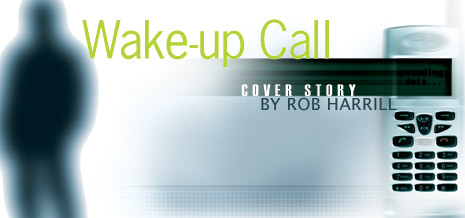

HENRY LAI HAS A VIVID RECOLLECTION OF HIS INTRODUCTION to the politics of big science. It was 1994, and he had just received a message from the National Institutes of Health, which was funding work he was doing on the effects of microwave radiation, similar to that emitted by cellular phones, on the brain. He and UW colleague Narendra "N.P." Singh had results indicating that the radiation could cause DNA damage in brain cells.
The news was apparently unwelcome in some quarters.
Someone had called the NIH to report that Lai was misusing his research funding by doing work not specified in the grant (the grant didn't mention DNA). And the agency wanted to know what was going on.
"It really scared the hell out of me," says Lai, a research professor in the UW's Department of Bioengineering who earned his Ph.D. from the UW in 1977. "I was awake all night, worrying about it, wondering what to do."
In the morning, he sent a fax to the agency, explaining how the research fell within the parameters of the grant. The NIH accepted his explanation and assured him that all was well. "They are usually fairly liberal in that regard," Lai says. "To do otherwise would stifle the scientific process."
 The incident, he says, was only the beginning in a David-and-Goliath conflict pitting him-and other researchers-against an emerging technology that would rapidly become one of the most lucrative and powerful businesses on the planet: the cell phone industry.
The incident, he says, was only the beginning in a David-and-Goliath conflict pitting him-and other researchers-against an emerging technology that would rapidly become one of the most lucrative and powerful businesses on the planet: the cell phone industry.
The controversy goes back to a study by Lai and Singh published in a 1995 issue of Bioelectromagnetics. They found an increase in damaged DNA in the brain cells of rats after a single two-hour exposure to microwave radiation at levels considered "safe" by government standards.
The idea behind that study was relatively simple: expose rats to microwave radiation similar to that emitted by cell phones, then examine their brain cells to see if any DNA damage resulted. Such damage is worrisome because DNA carries the body's genetic code and breaks, if not repaired properly, could lead to mutations and even cancer.
When the study was first published, a spokesperson from the cell phone industry said it was "not very relevant because they didn't use the [same] cellular frequency or cellular power."
True, responds Lai. But effects at one frequency could also happen at another frequency, and the exposure level in the experiment was actually lower than one can get from a cell phone. What it indicated was potential problems with the type of radiation the devices emit.
To this day, the cell phone industry continues to dispute Lai and Singh's findings.
"I don't believe any of those studies have ever been replicated," says Joe Farren, director of public affairs for CTIA-The Wireless Association, a Washington, D.C.-based industry consortium that provides $1 million a year in funding for cell phone research. "We believe you should follow the science. The science to date shows there is not a health risk associated with the use of any wireless device."
Technically, Farren may be correct about Lai's study, but that's because no one has tried to replicate Lai and Singh's exact experiment. And a 1998 experiment that used common cell phone frequencies did find biological damage in some cases. More recently, a European research effort by 12 groups in seven countries also documented DNA damage from cell phone radiation.
 While Lai is the first to say there are "no solid answers" to the controversy over cell phones and DNA damage, there is "cause for concern" and more work needs to be done. Instead, Lai says, he and his colleague have been the focus of a campaign to discredit their research. Consider:
While Lai is the first to say there are "no solid answers" to the controversy over cell phones and DNA damage, there is "cause for concern" and more work needs to be done. Instead, Lai says, he and his colleague have been the focus of a campaign to discredit their research. Consider:
The stakes, both in terms of potential ramifications and profits, are high. According to consulting firm Deloitte & Touche, the global wireless market is expected to grow to two billion subscribers by the end of this year. An overall dollar figure for the industry would easily be in the hundreds of billions, according to Louis Slesin, who as editor of Microwave News has followed the ins and outs of research in the field of bioelectromagnetics for more than 20 years.
Go To: Page 1 | Page 2 | Page 3 | Page 4
Inside the Wave: Web exclusive on more cell phone radiation research
Making Waves: Worrisome results from European cell phone study
Old Medicine, New Cure?: Henry Lai's cancer research shows promise